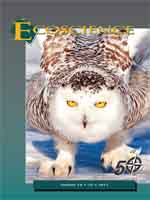Milne Fiord in the Canadian High Arctic contains the last known ice-dammed fiord lake (epishelf lake) in the Northern Hemisphere. This freshwater ecosystem is retained by the Milne Ice Shelf and is underlain by sea water that is connected to the Arctic Ocean. Using microscopy, photosynthetic pigment analyses, and molecular techniques we examined the planktonic communities present in Milne Fiord to determine the biotic characteristics of the epishelf lake and the sea water below. Net sampling of the water column of Milne Fiord revealed a mixture of marine, freshwater, and brackish Zooplankton taxa, and high performance liquid chromatography (HPLC) pigment analysis showed pronounced differences in phytoplankton composition through the highly stratified water column. Chlorophytes dominated in the epishelf lake, prasinophytes prevailed in the halocline, and the bottom layer harboured mainly fucoxanthin-containing groups. Clone libraries of a dark-incubated, concentrated sample from below the halocline (30 m depth) yielded marine Archaea (mainly Crenarchaeota) and known bacterial taxa from the Pacific and Arctic oceans (e.g., Roseobacter, Oleispira, Colwellia). An equivalent sample from the epishelf lake (5 m depth) yielded many bacterial taxa that are characteristic of cold, freshwater habitats (e.g., Polynucleobacter, Variovorax, Flavobacterium), the euryhaline genus Polaromonas, and freshwater eukaryotes, notably ciliates. Similarly, denaturing gradient gel electrophoresis (DGGE) analyses of T4-like bacteriophages showed different viral assemblages in the upper and lower water column. This diverse, stratified ecosystem is dependent on the integrity of the bounding ice shelf and is therefore vulnerable to the ongoing effects of climate change in this region.
How to translate text using browser tools
1 September 2011
Milne Fiord Epishelf Lake: A Coastal Arctic Ecosystem Vulnerable to Climate Change
Julie Veillette,
Connie Lovejoy,
Marianne Potvin,
Tommy Harding,
Anne D. Jungblut,
Dermot Antoniades,
Caroline Chénard,
Curtis A. Suttle,
Warwick F. Vincent
ACCESS THE FULL ARTICLE
<
Previous Article
|

Ecoscience
Vol. 18 • No. 3
September 2011
Vol. 18 • No. 3
September 2011




